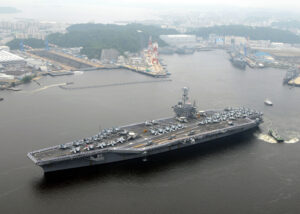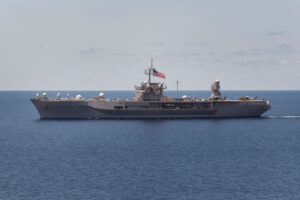The US Navy in East Asia
For more than 70 years, the US Navy's 7th Fleet, established in 1943, has maintained a permanent force presence in the waters of East Asia. The 124 million square kilometre area of responsibility covers the western half of the Pacific Ocean and most of the Indian Ocean; it runs from 180 degrees longitude (dateline) to the coastal boundary line between India and Pakistan and from the Kuril Islands down to Antarctica. There are 36 coastal or island states in the area in question, which together make up fifty per cent of the world's population.
These 36 nations include five allied states (Australia, Japan, the Philippines, South Korea and Thailand), as well as (not including the USA) the five states with the largest armed forces in the world (India, North Korea, Russia, South Korea and the People's Republic of China).
It is not surprising that the 7th fleet the largest of those stationed abroad US fleets is. The permanent presence has both a high political and military value. It takes 17 days to move warships from the US West Coast to this strategically important region. Fleet units and personnel participate in approximately 100 bi- and multinational exercises in the region each year and conduct approximately 200 port visits annually; approximately half of the available units are at sea or visiting a port in the region at any given time. Main tasks of the 7th fleet are: Command and control of all US Navy forces in the area of responsibility in peacetime; operational command (also in a multinational or joint TSK framework) in the event of acts of war or humanitarian measures within the area of responsibility; maritime defence of South Korea. Of increasing importance is also the defence against ballistic missiles both within the region and for the protection of US territory.

The 7th fleet At any given time, at least 30 warships and submarines, up to 50 (partly leased) logistics and supply ships, up to 300 aircraft (including helicopters) and around 40,000 sailors and marines are under its command. These figures include both the permanent forces of the 7th fleet as well as additional forces deployed on a rotational basis from the US West Coast and Hawaii. All US Navy units merely transiting the waters of the area of responsibility will also be assigned to the command of the US Navy for this period. 7th fleet assumed. The 7th fleet 24 warships are permanently assigned: the aircraft carrier USS GEORGE WASHINGTON (CVN 73, to be replaced this summer by CVN 76 USS RONALD REAGAN); the lead ship USS BLUE RIDGE (LCC 19); two TICONDEROGA-class guided-missile cruisers; seven ARLEIGH BURKE-class guided-missile destroyers; four amphibious warships; four AVENGER-class mine warfare ships; three LOS ANGELES-class attack submarines; and two submarine tenders.

The commander has been Vice Admiral Robert Thomas since October 2013. The headquarters are located in Yokosuka, on Tokyo Bay, around 65 kilometres south of the Japanese capital. Most of the surface warships are also stationed here. The amphibious ships and mine warfare forces are based in Sasebo on Kyushu, the southernmost of Japan's four main islands. The fighter submarines of the 7th fleet are located on Guam. The approximately 75 aircraft of the 5th Carrier Air Wing are stationed at Atsugi Naval Air Base, north-west of Yokosuka, when they are not deployed. The maritime reconnaissance aircraft are based at an outpost of Atsugi. Finally, a logistics centre of the 7th fleet in Singapore, where the majority of logistics ships are based.
The permanently assigned ships are divided into different strike groups or squadrons: Carrier Strike Group 5, CSG 5 for short (aircraft carriers and cruisers); Destroyer Squadron 15, DESRON 15 for short (destroyers); Mine Countermeasures Squadron 7 (MCM Squadron 7, mine countermeasures ships and helicopters); Submarine Squadron 15 (fighter submarines). In December 2012, Destroyer Squadron 7 (DESRON 7) was also relocated from California to Singapore and the 7th fleet Despite continuing to use the name Destroyer Squadron, this unit is primarily responsible for planning and conducting the CARAT (Cooperation Afloat Readiness and Training) exercise series, which is carried out annually together with nine Asian partner nations. The littoral combat ships assigned to Singapore are also subordinate to DESRON 7.
Task forces
The emergency services of the 7th fleet are organised into subordinate task force (TF) units depending on their type and mission.
- TF 70 / Battle Force, 7th Fleet (Location: Yokosuka)
The surface warships are subordinate to TF 70. These ships are organised into two different strike groups. Carrier Strike Force 7 currently consists of USS GEORGE WASHINGTON and its escort ships, but may include more than one aircraft carrier. Surface Combatant Force 7 consists of the cruisers, destroyers and frigates not attached to the aircraft carrier group. The commander of the GEORGE WASHINGTON aircraft carrier group always acts in personal union as commander of Task Force 70 and is responsible for all areas of naval warfare on the part of the 7th fleet responsible. - TF 71 / Navy Special Warfare Unit 1 (Location: Guam)
TF 71 includes special forces as well as parachute qualified demolition experts. The unit also carries out search & rescue and recovery missions. - TF 72 / Patrol and Reconnaissance Force, 7th Fleet (Location: Atsugi)
TF 72 is primarily used to command the maritime patrol aircraft and ASW aircraft of the 7th fleet. Operational detachments fly from the bases at Kadena on Okinawa and Misawa in the north of the main Japanese island of Honschu. Ships can be deployed to TF 72 at any time to support the reconnaissance mission. - TF 73 / Logistics Group, Western Pacific (Location: Singapore)
TF 73 is used to manage the logistics ships and other supply and support vessels of the 7th fleet. - TF 74 / Submarine Force, 7th Fleet (Location: Guam)
TF 74 is responsible for the command and coordination of the fighter submarines in the area of responsibility of the 7th fleet. This includes coordinating the voyages of US submarines and the underwater forces of friendly states in order to avoid clashes and conflicts. - TF 75 / Navy Expeditionary Forces Command, Pacific, 7th Fleet (Location: Guam)
The term "expeditionary forces" includes combat and combat support forces that contribute to the access of the fighting units of the fleet, including the naval infantry. These include: Riverine combat units, reconnaissance and fleet intelligence forces, sappers, demolition experts, and divers. - TF 76 / Amphibious Force, 7th Fleet / Expeditionary Strike Group 7 (Location: Sasebo)
TF 76 consists of the amphibious ships and landing craft of the 7th fleet and from the mine warfare forces of MCM Squadron 7. - TF 77 / Mine Warfare Force, 7th Fleet
In contrast to the other task forces, the mine warfare unit is only activated when required. The task forces consist of mine warfare ships and helicopters and are deployed by the Mine Warfare Command in California. - TF 78 / US-Naval Forces, Korea (locations: Yongsan and Chinhae, Korea)
The commander of the 7th fleet also assumes operational command of the South Korean naval forces in the event of war. 7th fleet form a joint war-fighting naval command. TF 78 serves as a liaison centre between the South Korean and US naval forces as well as to the TSK-joint US high command and the multinational UN high command, all located in Yongsan near Seoul. No forces are assigned to TF 78. - TF 79 / Landing Force, 7th Fleet
TF 79 is a standing amphibious ready group, generally the size of a MEU unit (Marine Expeditionary Unit, a battalion reinforced by artillery, logistics and aviation forces). The MEU unit is provided on a rotational basis by US Marine Corps forces stationed on Okinawa.
"Swing" into the Pacific region
The planned relocation of additional US forces from the Atlantic to the Pacific region will increase the importance of the 7th fleet fundamentally increase. At the same time, the performance of the permanently forward-deployed units will be increased. For example, two additional destroyers designed for ballistic missile defence are to be transferred to Japan by 2017. Two of the older mine warfare vessels stationed in Sasebo were already replaced by two more modern, better equipped units in summer 2014.
According to the current plans, the US Navy is to station around 60 per cent of its forces in the Pacific region and only 40 per cent in the Atlantic region by 2020. Even if most of the American warships and aircraft to be relocated are moved to the west coast of the USA and not to Asia, an increase in the regular deployment of these forces to the area of responsibility of the US Navy is to be expected. 7th fleet to be expected. With this in mind, new agreements are being concluded with countries in the region (including the Philippines and Australia) in order to guarantee or expand port call rights and supplies in the respective partner's harbours. Joint exercises and training programmes will also be intensified. A permanent presence of four LCS units is to be established in Singapore by 2018; to date, only individual LCS have been deployed to Singapore on a rotational basis. Guam's naval harbour will be expanded to accommodate additional submarines and warships. The current tensions with Russia threaten to dampen the pace and possibly the extent of the "swing" to Asia. In view of the existing tensions on the Korean peninsula and the increasing willingness of both China and the Pacific littoral state Russia to confront each other, the utilisation of the 7th fleet nevertheless only increase in the coming years.
Author: Sidney E. Dean










